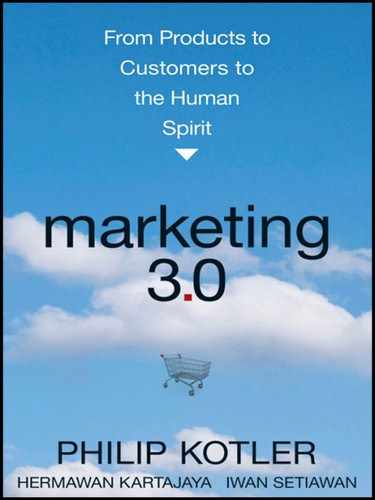PREFACE
The world is going through a period of rapid and wrenching changes. The recent financial meltdown has unfortunately increased the level of poverty and unemployment, developments that are now being fought with stimulus packages around the world to restore confidence and economic growth. In addition, climate change and rising pollution are challenging countries to limit the release of carbon dioxide into the atmosphere, but at the cost of imposing a higher burden on business. Furthermore, the rich countries of the West are now experiencing a much slower rate of growth, and economic power is rapidly shifting to countries in the East that are experiencing higher rates of growth. And finally, technology is shifting from the mechanical world to the digital world—the Internet, computers, cell phones, and social media—which is having a profound impact on the behavior of producers and consumers.
These and other changes will require a major rethinking of marketing. The concept of marketing can be seen as the balancing concept to that of macroeconomics. Whenever the macroeconomic environment changes, so will consumer behavior change, and this will lead marketing to change. Over the past 60 years, marketing has moved from being product-centric (Marketing 1.0) to being consumer-centric (Marketing 2.0). Today we see marketing as transforming once again in response to the new dynamics in the environment. We see companies expanding their focus from products to consumers to humankind issues. Marketing 3.0 is the stage when companies shift from consumer-centricity to human-centricity and where profitability is balanced with corporate responsibility.
We see a company not as a sole and self-sustaining operator in a competitive world but as a company that operates with a loyal network of partners—employees, distributors, dealers, and suppliers. If the company chooses its network partners carefully, and their goals are aligned and the rewards are equitable and motivating, the company and its partners combined will become a powerful competitor. To achieve this, the company must share its mission, vision, and values with its team members so that they act in unison to achieve their goals.
We describe in this book how a company can market its mission, vision, and values to each of its major stakeholders. The company gets its profits by creating superior value for its customers and stakeholder partners. We hope that the company views its customers as its strategic starting point and wants to address them in their full humanity and with attention to their needs and concerns.
The book is structured into three key parts. In Part I, we summarize the key business trends that shape the human-centric marketing imperative and lay the foundation for Marketing 3.0. In Part II, we show how the company can market its corporate vision, mission, and values to each of its key stakeholders—consumers, employees, channel partners, and shareholders. In Part III, we share their thoughts on several key implementations of Marketing 3.0 for solving global issues such as wellness, poverty, and environmental sustainability and how corporations can contribute by implementing the human-centric business model. Finally, the Epilogue chapter summarizes the 10 key ideas of Marketing 3.0 with select examples of companies that embrace the concept in their business model.
NOTE ON THE ORIGIN OF THIS BOOK
The idea of Marketing 3.0 was first conceptualized in Asia back in November 2005 by a group of consultants at MarkPlus, a Southeast Asian-based marketing services firm led by Hermawan Kartajaya. After two years of co-creation to enhance the concept, Philip Kotler and Hermawan Kartajaya launched the draft manuscript at the 40th anniversary of the Association of Southeast Asian Nations (ASEAN) in Jakarta. The only G-20 member in Southeast Asia, Indonesia is a nation where human centricity and the character of spirituality overcome the challenges of diversity. The president of the United States, Barack Obama, spent four years of his early education in Indonesia to learn about the human centricity of the East. Marketing 3.0 was born and shaped in the East, and we are honored to have a Foreword by Susilo Bambang Yudhoyono, President of the Republic of Indonesia.
Iwan Setiawan, one of the MarkPlus consultants who initiated the concept, collaborated with Philip Kotler at Northwestern University’s Kellogg School of Management—one of the world’s top business schools in the West—to enhance the relevance of Marketing 3.0 with the emergence of the new world economic order and the rise of the digital world.
..................Content has been hidden....................
You can't read the all page of ebook, please click here login for view all page.
